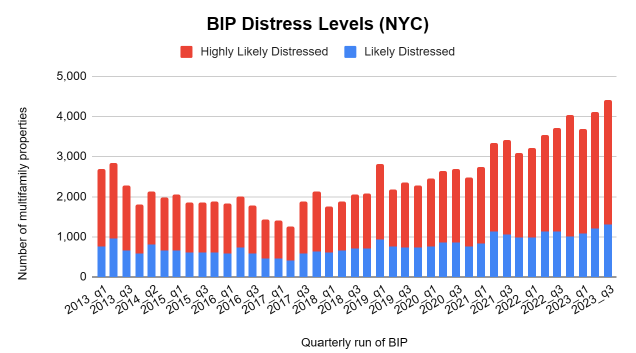The Building Indicator Project Database
The Building Indicator Project is a database developed by UNHP to identify NYC multifamily properties in physical and/or financial distress. In its current form, BIP has aggregated more than a decade of data for all 70,000+ rental buildings in NYC, tracking more than 120 data-points for each building. BIP also employs a scoring system, developed in collaboration with financial institutions, advocates, property managers, and researchers in order to identify buildings likely or highly likely to be in distress.

The BIP database is updated quarterly and used by various partners, including 47 community organizations and advocacy groups, 7 agencies and 41 financial institutions, and significant bank regulators. Non-profits use BIP to identify distressed buildings in their catchment areas for organizing, build portfolios by landlord or lender, and conduct analysis to support advocacy. Financial institutions use the data to monitor properties in their lending portfolios and hold their borrowers accountable for conditions. During CRA examinations, regulatory bodies look at BIP scores for buildings within a bank portfolio to ensure loans meet community needs.
UNHP collects and shares the data and works with banking and community group partners to offer training, undertake specific research, and create and share information. Additionally, UNHP uses the BIP as a foundation for original research and work to address policy issues. One such example is a report entitled Gambling with Homes, or Investing in Communities, written in collaboration with the Local Initiatives Support Corporation. This research employed over a decade of BIP data to identify the effects on speculative housing investments on building quality and tenant stability.
The BIP database is part of UNHP's Multifamily Research and Action Center (MFRAC), a collaborative effort between University Neighborhood Housing Program (UNHP) and major multifamily lenders, foundations, public agencies, community-based organizations and managers to preserve affordable, quality housing in the Northwest Bronx and other low-income neighborhoods in NYC. UNHP's primary goal through MFRAC is to improve the living conditions and preserve the long-term affordability of multifamily rental units for low-income NYC households living in distressed housing, with a focus on the Bronx.